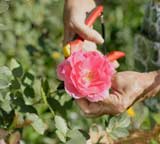Deadheading your roses is a part of caring for roses as well as your companion flowers. Even if you are just transplanting roses, growing roses for cuttings or simply growing miniature roses; all roses need deadheading. All roses must be pruned back or take part in deadheading which is the act of removing spent blossoms from your plants. This causes the plant to think it has not reproduced, so the plant then puts off re-growth hormones and produces another bloom to again try.
 With rose bush care, growing climbing roses or any type of rose tree gardens, deadheading your plants helps the plants to make more blooms and increases air circulation so disease is less likely to take place. Here are a few things you need to know about deadheading.
With rose bush care, growing climbing roses or any type of rose tree gardens, deadheading your plants helps the plants to make more blooms and increases air circulation so disease is less likely to take place. Here are a few things you need to know about deadheading.
Normal healthy roses without any diseases or mutations will have a blood stem no bigger around than the stem it is growing from. The blooms will be proportionate in their size to stems they grow from; so the further down you cut to deadhead, the bigger the blooms will grow but it will also take longer for another bloom to grow.
When cutting to deadhead your roses, your cuts should be made at angles away from the node. If you have a problem with mini wasps, seal the cut with glue; but generally the cut will seal on its own quickly. The stem growth from the nodes nearest the cut will begin afterwards. It is generally a decision you must make as to how far down the stem you should cut.
In rose gardening, it is always a matter of timing as to how well caring for roses or your rose gardening in general will turn out. If your roses offer large clusters of blooms, it is best to cut further down the stem. But if you are dealing with hybrids and constantly disbud, then deadheading that far down will affect how large the next blooms will be. This should be done based on how large you want the blooms to be and how fast you want the plant to recycle. Look for the true leaf to find where you should begin cutting; and after the plant is done blooming you can cut the stem back even further.
Older rose gardening pros who deal with rose tree gardens and growing climbing roses as well as growing miniature roses or knock out roses will offer that this only works for the plant to be able to bloom again. Many roses do not have the capability to do so on their own. If you don't want hips, deadheading will simply reduce insects such as pill bugs and earwigs.
By Lewis Paul










Join the Discussion
Type out your comment here:
You must be logged in to post a comment.